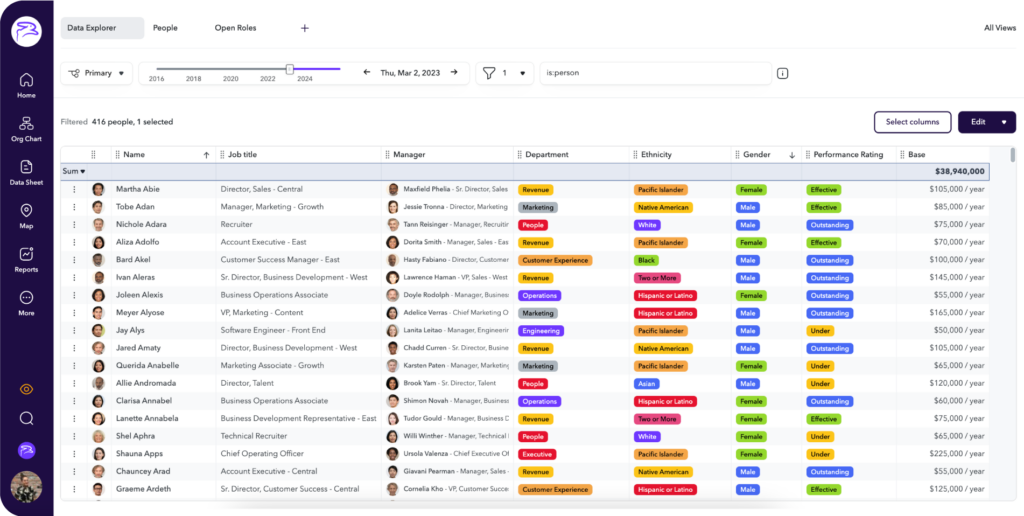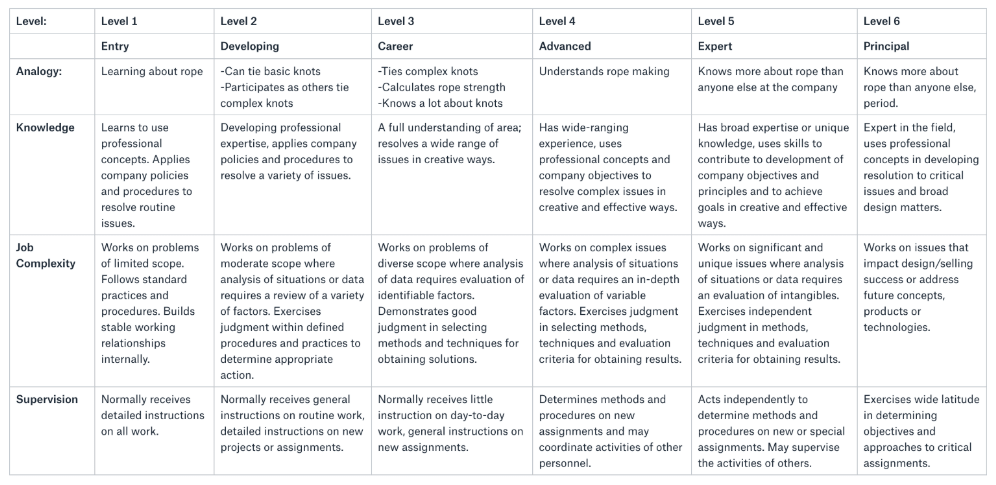
As a leader committed to diversity, equity, inclusion, and belonging (DEIB), you need to consistently analyze your organization’s practices to ensure you’re proud of your company policies and doing right by your people. Do you have outdated policies? Biased practices? It’s time to address those, ASAP.
One place to start – whether you’re a startup or an established organization – is salary transparency (and ideally, salary equity) to work toward creating a fair and equitable workplace.
Salary transparency – sometimes referred to as pay transparency – is a strategy to discuss employee compensation within your organization.
While this strategy almost always has a positive impact on company culture, it doesn’t look the same at every workplace.
And that’s okay.
Whether your company decides to publish salary ranges for roles and levels, include base pay and benefits in job descriptions, or literally disclose everyone’s salary, you’re intentionally choosing to build trust between your company, its employees, and its applicants.
Whichever option you choose, salary transparency allows employees to see how their (general or specific) salaries stack up against their coworkers’. Employees can then see that you offer fair, equal pay and a clear path for professional growth.
While more and more places require companies to post salary ranges in job postings (shoutout to New York City for headlining this trend), only a combined 12% of companies in the United States do so.
That being said, many companies have witnessed the benefits of pay transparency, since it provides a way to stay competitive and attract and retain the right talent …not to mention the opportunity to do right by your employees.
Have you heard of companies holding multiple-round interviews, only to disclose the salary at the time of offer? To be honest, it’s a lose-lose for everyone involved. Hiding salary ranges can create a bad rap from candidates, a culture of distrust among current employees, and makes it more difficult to uncover practices that contribute to inequality.
On the other hand, healthy transparency helps organizations and employees thrive. And when it comes to salary transparency, this looks like companies holding themselves accountable to employees so everyone can compare salaries across roles and departments. This level of transparency provides a lens into whether salaries are skill-based or a product of discrimination or unconscious bias.
But making the switch to salary transparency can be daunting, especially for an established company. But trust us – it’s possible.
In order to develop a solid, transparent strategy, it’s important to have an objective formula, clearly defined roles and growth levels, and benchmarks that help identify salary ranges.
Salary formulas allow companies to calculate pay based on objective metrics, such as met KPIs and concrete performance definitions. It’s how leaders show that salaries reflect concrete items and not subjective opinions of an individual’s value to the company.
Some companies, like Smile.io, use a location-based approach in their formula. When using the location-based approach, employees in the same position and level, living in the same location, receive similar or equivalent take-home pay. Location-based salaries can be complex to determine, since market rates, experience, cost of living, and income tax rates need to be taken into consideration.
Other companies like HelpScout favor a value-based approach to compensation, meaning employees are paid based on the value of their work. While this approach gives companies more flexibility to determine a salary, it may also introduce unintentional bias. If choosing this method, it’s important to create an objective system for evaluating team members’ skills and knowledge.
By comparing the two approaches, you can identify which better fits the goals of your company and helps work toward salary equity.
Ideally, a new or small organization can define roles and growth levels with minimal lift. But what if you work at an existing company with a large workforce? That was the problem Limeade ran into when they decided to build their compensation model.
Although they knew the overhaul was necessary, diving into roles and growth levels was a big job. But doing so highlighted their current issues, such as discrepancy in job titles and lack of structure around compensation.
Part of the strategy was also aligning salary equity to the bigger picture, says Marianna Hegyi, Limeade’s former Director of People. She advises other leaders to not consider compensation a separate entity, but instead suggests “looking at it in totality with the employee experience, connecting it with your culture, connecting it with your values.”
After analyzing data and leading six months of intense planning, Limeade rolled out internal pay transparency and now completes an annual analysis of pay grades and ranges.
The results of clearly defining roles and growth levels are important ones: your company builds trust with its current workforce, reduces promotion and compensation bias, becomes competitive in the job pool, and prepares leadership to become comfortable talking salaries with employees.
Once you define your roles and growth levels, the next step is determining benchmarks to help define salary ranges. In short, salary benchmarks allow People teams to compare salaries to similar companies, understand the job market and demand for positions, and create a competitive compensation and benefits package for future hires.
The People and Finance teams at ChartHop carefully followed this step and saw immediate benefits for themselves and applicants.
According to Ivori Johnson, ChartHop’s Director of Diversity, Equity, Inclusion, and Belonging, the company recognizes that:
By determining benchmarks for your salary ranges, you can create a transparent workplace and show your candidates respect even before they enter your organization.

Interested in streamlining your pay equity efforts? Of course you are. Consider using a people operations platform that houses all of your people data. With it, you can visualize your information and determine next steps.
It goes without saying that, for many people, professional growth and advancement is a priority. But how does this relate to DEIB? When companies provide specific skills-based criteria for advancement, employees of all backgrounds understand how they can rise to the next level. Definitive and differentiated criteria for roles and growth levels can also ensure your company remains objective and fair in employee advancement.
For companies starting out, it might be easier to establish roles with various levels. This also includes roles that will come with projected growth so that, as the company grows, employee advancement remains clear.
However, for an established company, creating levels for a role can present a challenge. It may be difficult to explicitly differentiate between a manager and senior manager in terms of skill or job complexity, but it is necessary work to achieve transparency and fairness.
For example, Buffer, along with companies like HelpScout, Chewse, and Medium, created career frameworks that clearly outline expectations at each level. These specific expectations then allow employees and their managers to strategize how the employee can advance and, as a result, increase compensation.

Buffer’s career levels for individual contributors, referred to in the company as “Makers.”
Ultimately, developing clear growth paths is an essential step toward long-term employee retention. LinkedIn’s Workplace Learning Report notes that employees working at companies with high opportunities for internal mobility stayed almost twice as long as those working in places with low mobility. Furthermore, clear growth paths work on removing any systemic barriers that might have otherwise had a negative effect on role promotion or salary increase.
How do you specify levels in a way that aligns with your company’s commitment to equality and fairness? That conversation is still growing, but here are a few things to consider:
With an internal salary transparency policy in place, you might consider making figures public by role. Additionally, adding salary ranges to job descriptions removes the need to provide a salary expectation during the interview process, which means candidates can focus more on getting an offer and less on pay bias.
Luckily, there are many options to provide transparent information about salaries. Some companies choose to dedicate part of their company website to disclosing salaries or discussing their salary formula, while others share details in a blog post or a letter from the CEO.
Another option is to include salaries or salary ranges in your job descriptions (and it’s a preferred and sometimes mandatory practice to do so). In fact, LinkedIn found that compensation was the most important part of job descriptions to potential candidates, and its presence drove more qualified candidates to apply.
Buffer can attest to the increase in candidates: they saw their job applicant pool double in size a month after they posted their employee salaries. And the company Glitch, which includes salary ranges on all job descriptions, has not only seen an increase in the number of applicants since doing so, but has also received positive feedback from candidates.
ChartHop also publishes their compensation bands for any applicant to see, not only for transparency, but also for advancing DEI initiatives. Johnson explains, “Published salary ranges advance DEI initiatives because more underestimated talent are seen to not negotiate in comparison to other talent.”
Fair and equal pay is long overdue, and salary transparency can help close the gap. But salary transparency isn’t a box that companies can check and move on from. By consistently reviewing your career frameworks and analyzing hiring and promotion practices, you can feel confident knowing you’re addressing potential issues that come with hidden salaries.
Change might take time, but salary transparency will continue to drive fair and equitable pay for employees. It’s exactly the kind of impactful work that your employees, no matter their backgrounds, expect and deserve from their employer.
Sign up for a free demo today.